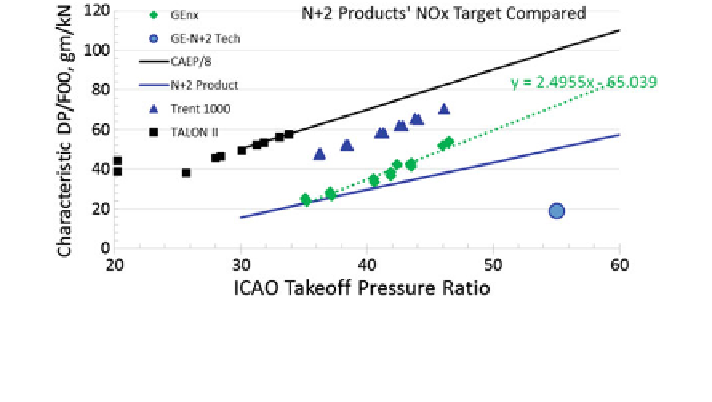Environmental Engineering Reference
In-Depth Information
NO
x
because GEnx average margin to CAEP8 is approximately 50 % compared to
5 % for the CF6-80C2; but the technologist has to worry about the slope of takeoff
NO
x
10
5
OPR
3
:
97
) compared to the CF6-80C2
for the GEnx (EINO
x
¼
1
:
08
112 OPR
1
:
59
. However, based on published TAPS technology
development experience, the
given by EINO
x
¼
0
:
'
first generation CFM-TAPS technology
s takeoff NO
x
is approximately 2
EINO
xGEnx
whereas that of the GE N + 2 Tech is given by an
unbelievable number 0
EINO
xGEnx
, as shown in Fig.
27
by two dotted lines
identified, respectively, as 2 and 0.2.
But what does it mean in regard to future NO
x
stringency regulations, especially
the long-term? This is discussed in Fig.
28
. The aviation engine combustion product
community has worked together in proposing and consenting to future ICAO
stringy regulations because they have not been used to try to eliminate quali
:
2
ed
competitors. Combustion technologists have pursued the long-term goal of 70 %
reduction in takeoff NO
x
since the early 1970s, Bruce et al.
1977
, which along with
gains in propulsion system ef
ciency gave approximately 80 % reduction from the
base CAEE regulation at 30 OPR, namely 20 g NO
2
/kN.
If we follow the trendline of stringencies set by CAEP4, CAEP6, and CAEP8
with the corresponding regulatory values of 67, 59, and 50.1 g NO
2
/kN at 30 OPR
along with the corresponding effective dates of December 31 of 2003, 2007, and
2013, we assume that the next
five rounds of NO
x
stringencies, each 4 year apart
would require the LTO NO
x
at 30 OPR not to exceed, respectively, 42.6, 36.2, 30.8,
26.2, and 22.2 gm NO
2
/kN. With a 30 % margin from the regulatory standard of
2033, the N + 2 product goal should be 0.7[-37.763 + 2OPR] as shown in Fig.
28
which also summarizes the current status of the best products, namely TALON II,
Trent1000, and GEnx in addition to the current regulation (CAEP/8) and GE N +2
technology as reported by Lee et al. (
2013
). We can safely assume that the next
round of TALON-X-based P&W combustion product will be at least as good as
Fig. 28 Characteristic landing
-
takeoff NO
x
of the latest engines (viz. GEnx, TALON II, and
Trent1000) and GE N + 2 technology compared to the most recent CAEP regulatory standard (viz.
CAEP/8) and potential CAEP long-term goal, CAEP LT. The N + 2 product goal is set with 30 %
margin to CAEP LT specified as
−
9.884 + 2
ˀ

Search WWH ::

Custom Search